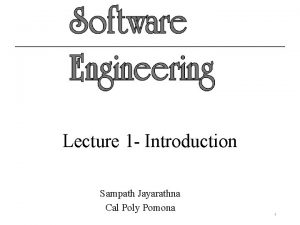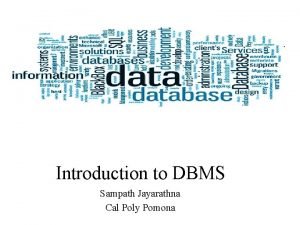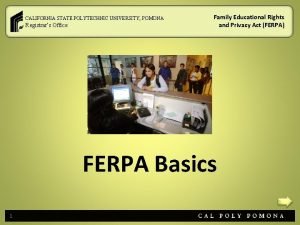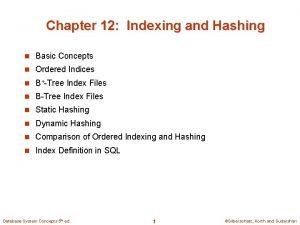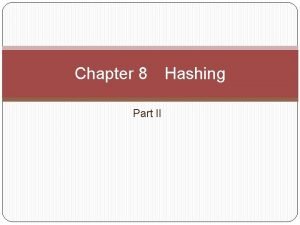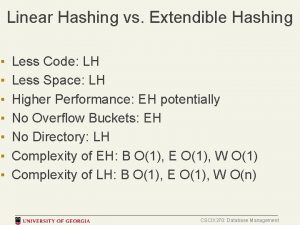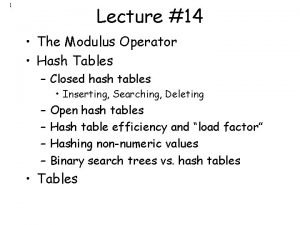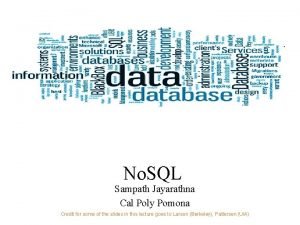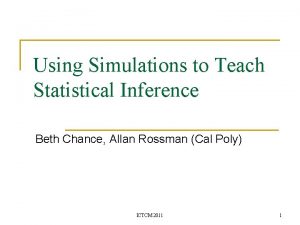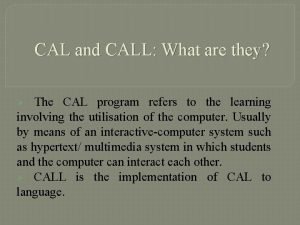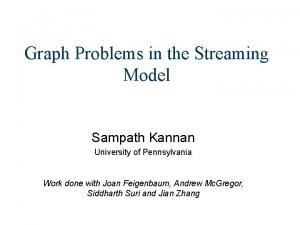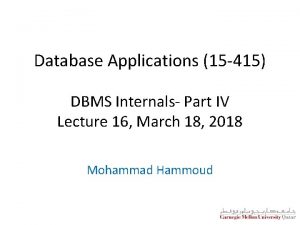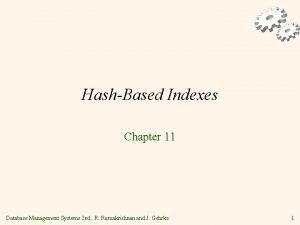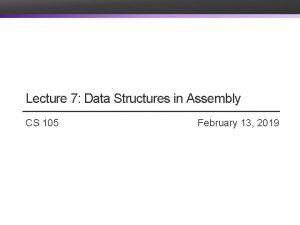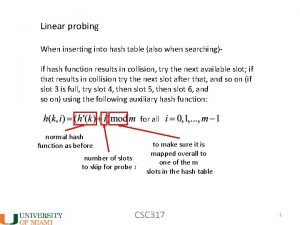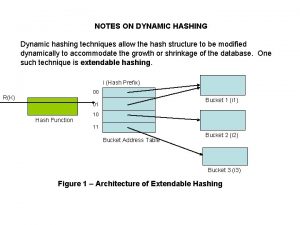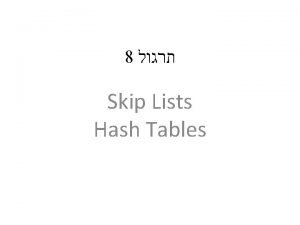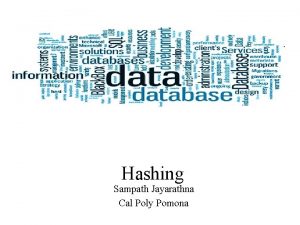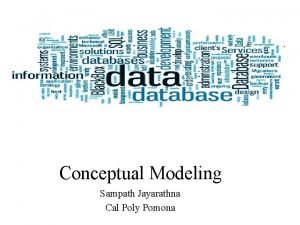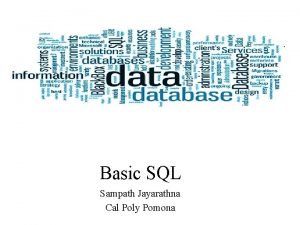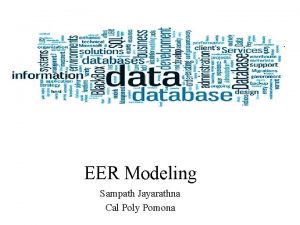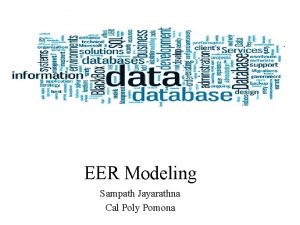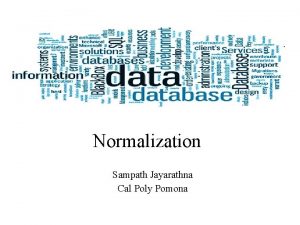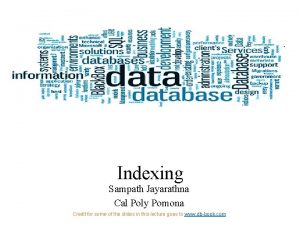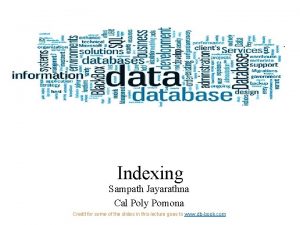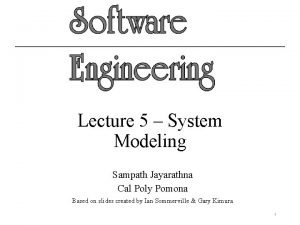Hashing Sampath Jayarathna Cal Poly Pomona Contents Static





































- Slides: 37

Hashing Sampath Jayarathna Cal Poly Pomona

Contents • Static Hashing • File Organization • Properties of the Hash Function • Bucket Overflow • Indices • Dynamic Hashing • Underlying Data Structure • Querying and Updating • Comparisons • Other types of hashing • Ordered Indexing vs. Hashing

My. SQL Hash Indexing • Hash indices are not supported on My. ISAM or Inno. DB database engines in My. SQL. Use MEMORY database engine if you want to use hash indexing

Static Hashing • Hashing provides a means for accessing data without the use of an index structure. • Data is addressed on disk by computing a function on a search key instead. h Data Page 1 Data Page 2 Data Page 3 : : : Data Page N-1 Data Page N

Organization • A bucket in a hash file is unit of storage (typically a disk block) that can hold one or more records. • The hash function, h, is a function from the set of all searchkeys, K, to the set of all bucket addresses, B. • Insertion, deletion, and lookup are done in constant time. • Records with different search-key values may be mapped to the same bucket; thus entire bucket has to be searched sequentially to locate a record. • Typical hash functions perform computation on the internal binary representation of the search-key. • For example, for a string search-key, the binary representations of all the characters in the string could be added and the sum modulo the number of buckets could be returned.

Querying and Updates • To insert a record into the structure compute the hash value h(Ki), and place the record in the bucket address returned. • For lookup operations, compute the hash value as above and search each record in the bucket for the specific record. • To delete simply lookup and remove. Hash file organization of instructor file, using dept_name as key E. g. h(Music) = 1 h(History) = 2 h(Physics) = 3 h(Elec. Eng. ) = 3

Properties of the Hash Function • Worst hash function maps all search-key values to the same bucket • this makes access time proportional to the number of search-key values in the file. • The distribution should be uniform. • An ideal hash function should assign the same number of records in each bucket. • The distribution should be random. • Regardless of the actual search-keys, the each bucket has the same number of records on average • Hash values should not depend on any ordering or the search-keys

Bucket Overflow • How does bucket overflow occur? • Not enough buckets to handle data • A few buckets have considerably more records then others. This is referred to as skew in distribution of records. • Multiple records have the same hash value • Chosen hash function produces non-uniform distribution of key values. • Although the probability of bucket overflow can be reduced, it cannot be eliminated; it is handled by using overflow buckets.

Solutions: Closed Hashing • Provide more buckets than are needed. • Overflow chaining • If a bucket is full, link another bucket to it. Repeat as necessary. • The system must then check overflow buckets for querying and updates. This is known as closed hashing.

Solutions: Open Hashing • Open hashing • The number of buckets is fixed • Overflow is handled by using the next bucket in cyclic order that has space. • This is known as linear probing. • Compute more hash functions.

Hash Indices • A hash index organizes the search keys, with their pointers, into a record.

Static Hashing § A hash structure (or table or file) is a generalization of the simpler notion of an ordinary array § A hash function h is used to map keys into a range of bucket numbers h(key) mod N key With Static Hashing, allocated sequentially and never de-allocated 0 2 With Static Hashing, allocated (as needed) when corresponding buckets become full h N-1 Primary bucket pages Overflow pages

Deficiencies of Static Hashing • In static hashing, function h maps search-key values to a fixed set of B of bucket addresses. • Databases grow or shrink with time. If initial number of buckets is too small, and file grows, performance will degrade due to too much overflows. • If space is allocated for anticipated growth, a significant amount of space will be wasted initially (and buckets will be underfull). • If database shrinks, again space will be wasted. • One solution: periodic re-organization of the file with a new hash function • Expensive, disrupts normal operations • Better solution: allow the number of buckets to be modified dynamically. • Dynamic Hashing (Extendible Hashing, Linear Hashing)

Directory of Pointers § How else (as opposed to overflow pages) can we add a data record to a full bucket in a static hash file? § Reorganize the table (e. g. , by doubling the number of buckets and redistributing the entries across the new set of buckets) § But, reading and writing all pages is expensive! § In contrast, we can use a directory of pointers to buckets § Buckets number can be doubled by doubling just the directory and splitting “only” the bucket that overflowed § The trick lies on how the hash function can be adjusted!

Extendible Hashing § Extendible Hashing uses a directory of pointers to buckets GLOBAL DEPTH § The result of applying a hash function h is treated as a binary number and the last d bits are interpreted as an offset into the directory 4* 12* 32* 16* Bucket A 5* 21* Bucket B 2 00 1* 01 10 10* Bucket C 15* 7* 19* Bucket D 11 DIRECTORY § d is referred to as the global depth of the hash file and is kept as part of the header of the file DATA PAGES

Extendible Hashing: Searching for Entries § To search for a data entry, apply a hash function h to the key and take the last d bits of its binary representation to get the bucket number § Example: search for 5* 2 00 5 = 101 4* 12* 32* 16* 01 1* 10 5* 21* 10* 11 DIRECTORY 15* 7* 19* DATA PAGES Bucket A Bucket B Bucket C Bucket D

Extendible Hashing: Inserting Entries § An entry can be inserted as follows: §Find the appropriate bucket (as in search) §Split the bucket if full and redistribute contents (including the new entry to be inserted) across the old bucket and its “split image” §Double the directory if necessary §Insert the given entry

Extendible Hashing: Inserting Entries § Find the appropriate bucket (as in search), split the bucket if full, double the directory if necessary and insert the given entry § Example: insert 13* 2 00 13 = 1101 4* 12* 32* 16* 01 1* 10 5* 21* 13* 10* 11 DIRECTORY 15* 7* 19* Bucket A Bucket B Bucket C Bucket D

Extendible Hashing: Inserting Entries § Find the appropriate bucket (as in search), split the bucket if full, double the directory if necessary and insert the given entry § Example: insert 20* 2 FULL, hence, split and redistribute! 00 20 = 10100 4* 12* 32* 16* 01 1* 10 5* 21* 13* 10* 11 DIRECTORY 15* 7* 19* Bucket A Bucket B Bucket C Bucket D

Extendible Hashing: Inserting Entries § Find the appropriate bucket (as in search), split the bucket if full, double the directory if necessary and insert the given entry 32* 16* § Example: insert 20* 2 00 1* 01 20 = 10100 5* 21* 13* Bucket B 10 10* 11 DIRECTORY 15* 7* 19* Is this enough? Bucket A 4* 12* 20* Bucket C Bucket D Bucket A 2 (`split image' of Bucket A)

Extendible Hashing: Inserting Entries § Find the appropriate bucket (as in search), split the bucket if full, double the directory if necessary and insert the given entry 32* 16* § Example: insert 20* 2 00 1* 01 20 = 10100 Bucket A 5* 21* 13* Bucket B 10 10* 11 DIRECTORY 15* 7* 19* Double the directory and increase the global depth 4* 12* 20* Bucket C Bucket D Bucket A 2 (`split image' of Bucket A)

Extendible Hashing: Inserting Entries § Find the appropriate bucket (as in search), split the bucket if full, double the directory if necessary and insert the given entry 32* 16* Bucket A GLOBAL DEPTH § Example: insert 20* These two bits indicate a data entry that belongs to one of these two buckets 3 0 00 1* 5* 21* 13* Bucket B 001 010 011 10* Bucket C 15* 7* 19* Bucket D 4* 12* 20* Bucket A 2 (`split image' of Bucket A) 1 00 The third bit distinguishes between these two buckets! 101 110 111 But, is it necessary always to double the directory? DIRECTORY

Extendible Hashing: Inserting Entries § Find the appropriate bucket (as in search), split the bucket if full, double the directory if necessary and insert the given entry GLOBAL DEPTH § Example: insert 9* 3 000 32* 16* Bucket A FULL, hence, split! 1* 5* 21* 13* Bucket B 001 010 9 = 1001 011 10* Bucket C 15* 7* 19* Bucket D 4* 12* 20* Bucket A 2 (`split image' of Bucket A) 100 101 110 111 DIRECTORY

Extendible Hashing: Inserting Entries § Find the appropriate bucket (as in search), split the bucket if full, double the directory if necessary and insert the given entry GLOBAL DEPTH § Example: insert 9* 32* 16* Bucket A 3 000 1* 9* Bucket B 10* Bucket C 15* 7* 19* Bucket D 001 010 9 = 1001 011 100 101 Almost there… 110 111 DIRECTORY 4* 12* 20* Bucket A 2 (`split image‘ of A) 5* 21* 13* Bucket B 2 (`split image‘ of B)

Extendible Hashing: Inserting Entries § Find the appropriate bucket (as in search), split the bucket if full, double the directory if necessary and insert the given entry GLOBAL DEPTH § Example: insert 9* 32* 16* Bucket A 3 000 1* 9* Bucket B 10* Bucket C 15* 7* 19* Bucket D 001 010 9 = 1001 There was no need to double the directory! 011 100 101 110 111 When NOT to double the directory? DIRECTORY 4* 12* 20* Bucket A 2 (`split image‘ of A) 5* 21* 13* Bucket B 2 (`split image‘ of B)

Extendible Hashing: Inserting Entries § Find the appropriate bucket (as in search), split the bucket if full, double the directory if necessary and insert the given LOCAL DEPTH 3 entry GLOBAL DEPTH § Example: insert 9* 3 If a bucket whose local depth equals to the global depth is split, the directory must be doubled 3 000 1* 9* 001 2 010 9 = 1001 32* 16* Bucket A 011 10* Bucket C 100 2 101 15* 7* 19* 110 3 111 4* 12* 20* DIRECTORY 3 Bucket B Bucket D Bucket A 2 (`split image‘ of A) 5* 21* 13* Bucket B 2 (`split image‘ of B)

Extendible Hashing: Inserting Entries §Example: insert 9* Repeat… LOCAL DEPTH 3 32* 16* Bucket A GLOBAL DEPTH 3 000 2 FULL, hence, split! 1* 5* 21* 13* Bucket B 001 9 = 1001 010 2 011 10* Bucket C 100 Because the local depth (i. e. , 2) is less than the global depth (i. e. , 3), NO need to double the directory 101 2 110 15* 7* 19* Bucket D 111 3 DIRECTORY 4* 12* 20* Bucket A 2 (`split image' of Bucket A)

Extendible Hashing: Inserting Entries §Example: insert 9* Repeat… LOCAL DEPTH 32* 16* Bucket A GLOBAL DEPTH 3 3 000 1* 9* 001 2 010 9 = 1001 3 011 10* Bucket C 100 2 101 15* 7* 19* 110 3 111 4* 12* 20* DIRECTORY 3 Bucket B Bucket D Bucket A 2 (`split image‘ of A) 5* 21* 13* Bucket B 2 (`split image‘ of B)

Extendible Hashing: Inserting Entries §Example: insert 9* Repeat… LOCAL DEPTH 3 000 1* 9* 001 2 010 FINAL STATE! 32* 16* Bucket A GLOBAL DEPTH 3 9 = 1001 3 011 10* Bucket C 100 2 101 15* 7* 19* 110 3 111 4* 12* 20* DIRECTORY 3 Bucket B Bucket D Bucket A 2 (`split image‘ of A) 5* 21* 13* Bucket B 2 (`split image‘ of B)

Extendible Hashing: Inserting Entries §Example: insert 20* Repeat… FULL, hence, split! LOCAL DEPTH GLOBAL DEPTH 2 00 20 = 10100 Because the local depth and the global depth are both 2, we should double the directory! 2 4* 12* 32* 16* Bucket A 2 1* 5* 21* 13* Bucket B 01 10 2 11 10* DIRECTORY Bucket C 2 15* 7* 19* DATA PAGES Bucket D

Extendible Hashing: Inserting Entries §Example: insert 20* Repeat… LOCAL DEPTH 2 32*16* GLOBAL DEPTH 2 00 Bucket A 2 1* 5* 21*13* Bucket B 01 20 = 10100 10 2 11 10* Bucket C 2 Is this enough? DIRECTORY 15* 7* 19* Bucket D 2 4* 12* 20* Bucket A 2 (`split image' of Bucket A)

Extendible Hashing: Inserting Entries §Example: insert 20* Repeat… LOCAL DEPTH 2 32* 16* Bucket A GLOBAL DEPTH 3 000 2 1* 5* 21* 13* Bucket B 001 010 2 011 10* Bucket C 100 Is this enough? 101 2 110 15* 7* 19* Bucket D 111 2 DIRECTORY 4* 12* 20* Bucket A 2 (`split image' of Bucket A)

Extendible Hashing: Inserting Entries §Example: insert 20* Repeat… LOCAL DEPTH 3 32* 16* Bucket A GLOBAL DEPTH 3 000 2 1* 5* 21* 13* Bucket B 001 FINAL STATE! 010 2 011 10* Bucket C 100 101 2 110 15* 7* 19* Bucket D 111 3 DIRECTORY 4* 12* 20* Bucket A 2 (`split image' of Bucket A)

Class Activity 12 • Consider following state of the extendible hashing structure. Add 25, 60, 28 and show the final state.

Deletion in Extendable Hash Structure • To delete a key value, • locate it in its bucket and remove it. • The bucket itself can be removed if it becomes empty (with appropriate updates to the bucket address table). • Merging of buckets can be done (can merge only with a “split image” bucket) • Decreasing bucket address table size is also possible • Note: decreasing bucket address table size is an expensive operation and should be done only if number of buckets becomes much smaller than the size of the table

Comparison to Other Hashing Methods • Advantage: performance does not decrease as the database size increases • Space is conserved by adding and removing as necessary • Disadvantage: additional level of indirection for operations • Complex implementation • Bucket address table may itself become very big (larger than memory) • Need a tree structure to locate desired record in the structure! • Changing size of bucket address table is an expensive operation • Linear hashing is an alternative mechanism which avoids these disadvantages at the possible cost of more bucket overflows

Ordered Indexing vs. Hashing • Hashing is less efficient if queries to the database include ranges as opposed to specific values. • What indexing technique can we use to support range searches (e. g. , “Find s_name where gpa >= 3. 0)? • Tree-Based Indexing • In cases where ranges are infrequent hashing provides faster insertion, deletion, and lookup then ordered indexing. • What about equality selections (e. g. , “Find s_name where sid = 102”? • Tree-Based Indexing • Hash-Based Indexing • Hash-based indexing, however, proves to be very useful in implementing relational operators
 Cal poly quarter or semester
Cal poly quarter or semester Cal poly pomona software engineering
Cal poly pomona software engineering Cal poly databases
Cal poly databases Cal poly pomona registrar's office
Cal poly pomona registrar's office Cal poly pomona finance
Cal poly pomona finance Intern
Intern Static and dynamic hashing in dbms
Static and dynamic hashing in dbms Static hashing and dynamic hashing
Static hashing and dynamic hashing Odu student opinion survey
Odu student opinion survey Linear hashing
Linear hashing Modulo function c++
Modulo function c++ Cal poly database
Cal poly database Construction management cal poly
Construction management cal poly Quantitative analysis cal poly
Quantitative analysis cal poly Cal poly academic personnel
Cal poly academic personnel Beth chance
Beth chance Evd deloitte
Evd deloitte Cal poly triathlon
Cal poly triathlon Cal poly bike lockers
Cal poly bike lockers Chantal huynh
Chantal huynh Bqq
Bqq Ortak portal
Ortak portal Frank owen cal poly
Frank owen cal poly Cal and cal
Cal and cal Srinidhi sampath kumar
Srinidhi sampath kumar Sampath kannan
Sampath kannan P sampath
P sampath Sanjay sampath
Sanjay sampath What is static hashing in dbms
What is static hashing in dbms Static hashing
Static hashing What is static hashing in dbms
What is static hashing in dbms Ramaquois camp ny
Ramaquois camp ny Cs105 pomona
Cs105 pomona Pomona pd news
Pomona pd news Pomona workday
Pomona workday Hashing linear probing
Hashing linear probing Dynamic hashing allows us to
Dynamic hashing allows us to Difference between hashing and skip list
Difference between hashing and skip list

